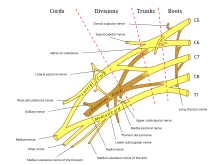| Erb's palsy | |
|---|---|
| Other names | Erb–Duchenne palsy |
 | |
| Brachial plexus. Erb's palsy primarily affects C5 and C6. | |
| Specialty | Pediatrics |
| Treatment | Nerve transfers, subscapularis releases and latissimus dorsi tendon transfers |
Erb's palsy is a paralysis of the arm caused by injury to the upper group of the arm's main nerves, specifically the severing of the upper trunk C5–C6 nerves. These form part of the brachial plexus, comprising the ventral rami of spinal nerves C5–C8 and thoracic nerve T1.[1][2][3] These injuries arise most commonly, but not exclusively, from shoulder dystocia during a difficult birth.[4] Depending on the nature of the damage, the paralysis can either resolve on its own over a period of months, necessitate rehabilitative therapy, or require surgery.[5]
- ^ Warwick, R.; Williams, P.L., eds. (1973). Gray's Anatomy (35th ed.). London: Longman. pp.1037–1047
- ^ Tortora, G.J. & Anagnostakos, N.P. (1990). Principles of Anatomy and Physiology (6th ed.). New York: Harper & Row. ISBN 978-0-06-046694-7. pp.370–374
- ^ Abrahams, P (2002). The Atlas of the Human Body: A Complete Guide to How the Body Works. Leicester, U.K.: Silverdale Books. ISBN 978-1-85605-699-1. pp.76–77
- ^ A.D.A.M Healthcare center Archived 2008-06-03 at the Wayback Machine
- ^ "Erb–Duchenne and Dejerine–Klumpke Palsies Information Page: National Institute of Neurological Disorders and Stroke (NINDS)". Archived from the original on 2016-12-02. Retrieved 2008-05-29.